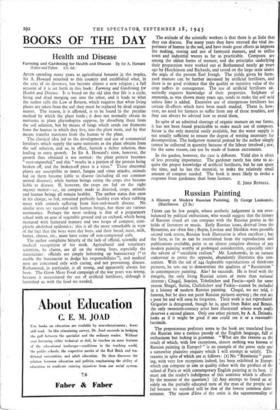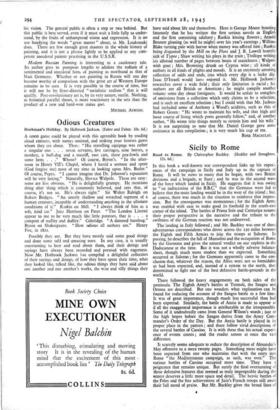Russian Painting
A History of Modern Russian Painting, By George Loukomski. (Hutchinson. £2 2s.) A History of Modern Russian Painting, By George Loukomski. (Hutchinson. £2 2s.) THERE can be few people, whose aesthetic judgement is not over- balanced by political enthusiasm, who would suggest that the history of Russian visual art can compare with the Russian genius in the fields of literature or music. Early Russian icons, derived from the Byzantine, are often fine ; Repin, Levitan and Shishkin were passable second rank artists, Russian book illustration is often excellent ; but the facts, as far as can be ascertained from the reproduction and publications available, point to an almost complete absence of any modern painting worthy of prolonged consideration, especially since the advent of " socialistic realism." Mr. Loukomski, in an earnest endeavour to prove the opposite, abundantly illustrates this con- tention. With the aid of 244 deplorable reproductions of third-rate pictures, he sets out to demonstrate the qualities of " Russianism " in contemporary painting. Alas! he succeeds. He is brief with the émigrés, the only living Russian artists of more than national interest ; Chagal, Soutine, Tchelitchev and Passim—spelt for some reason Shagal, Sutini, Chelishchev and Paskin—cannot be included in a history ef modern Russian painting. Chagal, we are told, is famous, but he does not paint Russian pictures anyway ; the rest are a poor lot and will soon be forgotten. Their work is not reproduced. Grigoriev is denigrated, though he is, apart from Bakst and Benois, the only twentieth-century artist here illustrated whose work really deserves a second glance. Only one other picture, by A. A. Deineka, looks as if it might be good if one could see it or a reasonable facsimile.
The preposterous prefatory notes to the book are translated from the Russian into a curious parody of the English language, full of enthusiasm but lacking in grammar. " What are the reasons as the result of which, with few exceptions, almost nothing was known of Russian painting in Europe? is an example of the prose style and a somewhat plaintive enquiry which I will attempt to satisfy. The reasons in spite of which are as follows : (a) No " Russianist " paint- ing, with very few exceptions indeed, has been exhibited in Europe which can compare in aim or quality either with the product of the school of Paris or with contemporary English painting at its best. (I must ask the reader's indulgence of this sentence which is affected by the manner of the question.) (2) Any attempt to found an art solely on the partially educated taste of the man of the people wil, fail because its standard will be that of the lowest common deno- minator. The raison d'être of the artist is the supernormality of
his vision. The general public is often a step or two behind. But this public is best served, even if it must wait a little fully to under- stand, by the fruits of unhampered vision and expression. It is no use bandying the words "great master " about, as Mr. Loukomski does. There are few enough great masters in the whole history of painting, and it is not a phrase lightly to be applied to any com- petent anecdotal painter practising in the U.S.S.R.
Modern Russian Painting is interesting as a cautionary tale. Its author goes to pompous lengths to adulate the tedium of a sentimental and anecdotal form of painting as moribund as that of Nazi Germany. Whether or not painting in Russia will one day become worthy of comparison with the great art of Western Europe remains to be seen. It is very possible in the course of time, but it will not he by State-directed " socialistic realism " that it will qualify. Post-revolutionary art is, by its very nature, sterile. Nothing, as historical parallel shows, is more reactionary in the arts than the product of a new and hard-won status quo.
MICHAEL AYRTON.



























 Previous page
Previous page